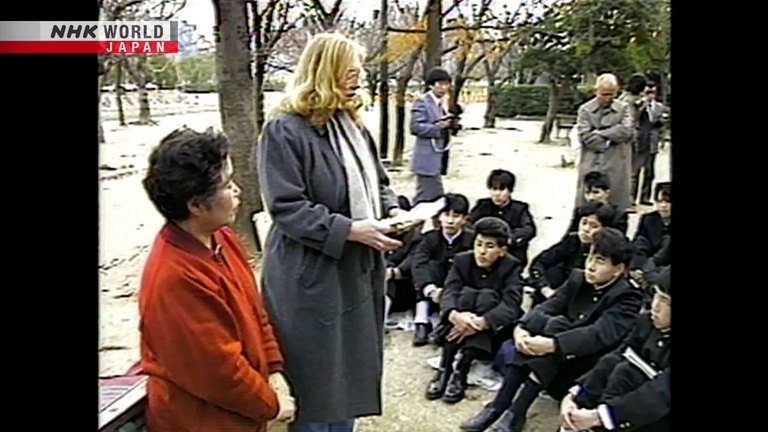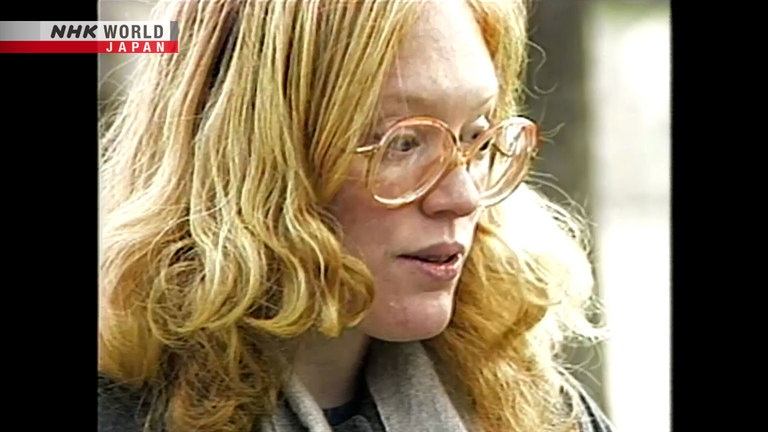Revealing the True Horrors of the Atomic Bomb: Leslie Sussan / Anti-Nuclear Activist
Leslie Sussan became an anti-nuclear activist after discovering her father's films of victims of the atom bomb that filmed in Japan and long suppressed by the US military. Her work fulfills his legacy.


Transcript
Direct Talk
In August 1945,
the atomic bomb caused more than 200,000 deaths
in Hiroshima and Nagasaki,
beginning the nuclear age we live in today.
Leslie Sussan is an anti-nuclear activist,
and former lawyer.
For more than 20 years, she has been telling
the world of the horrors of the atomic bomb.
Sussan warns that, with the world facing
nuclear threats like never before,
now is when we need to wake up
to the truth about nuclear weapons.
Revealing the True Horrors of the Atomic Bomb
I think it's critical.
I think that for a long time,
people both in the U.S. and in the world
became kind of complacent.
They became used to the idea,
okay, nuclear weapons exist,
but now they've existed a long time.
Nothing terrible happened.
So maybe it's not so serious.
And partly I think that's because
they don't have a real sense of the reality
of what nuclear weapons can do.
The people who have seen it are gone,
almost all of them.
And meanwhile, we have two nuclear powers
that are at war at the same time.
Israel and Russia
are both at war now,
and they are, both countries have been
talking about using nuclear weapons.
So that's one reason, I think, that it's
crucial for people now to really understand
what these weapons can do and
how much worse they've become in the time
since their use in Hiroshima and Nagasaki.
Sussan's anti-nuclear work was inspired by
the long-hidden story of her father,
Herbert Sussan, who served in the US army.
Several months after the atomic bombings,
the US strategic bombing survey
was sent to Japan
to record the effects of the bombs on film.
Herbert spent four months there
as part of this mission.
In January 1946,
Herbert was shocked by what he saw
when he landed in Hiroshima and Nagasaki.
He was just 22 years old.
Confronted by the tragic reality before him,
he started filming the suffering of victims,
which was not included in his assignment.
He didn't know anything about, you know,
radiation or atomic weapons or,
you know, all he knew was when they
declared victory that these, you know, sort of
super weapons, magical weapons,
ended the war.
This was great,
but that's all he knew about it.
It was after he was in Nagasaki
for a little time,
that he started to visit the hospitals
and see the people.
And he was stunned because
the hospitals were filled with people.
There wasn't much hospital left,
but even so, the shells of the hospitals
were filled with people
who were getting sicker and sicker, and
had injuries like he had not ever seen before.
And you know, he did,
he was asking questions of what,
what is this?
This is this, you know,
the war is over, but this war isn't over.
This people are still like
the war is going on.
They're still suffering and dying.
And so he asked for permission,
you know, to stay longer
and do more filming in the hospitals,
because I think
the original plan of the crew was
to film the physical effects of the bomb.
You know how at different distances,
different geographies.
Different materials.
What was the effect?
But my father was interested in the people.
Somewhere in the process,
he went from just feeling like, you know,
we have to let the government know this,
something terrible happened here
to thinking we have to share
this record with the world.
He started to think,
this is not just a record.
This is something that the world has to see.
He really thought once anyone saw this,
they would never want
such a weapon to exist in the world.
And so if he makes a good, clear record
and, you know, brings it back to people,
you know, first, he thought the military
wouldn't want to ever own such a weapon.
And then if they still want it,
then surely the American people will say no.
But the US army designated
the film as "classified,"
available only for use in military training.
In protest, Herbert resigned from the army.
I think he was
heartbroken and bitter.
You know, he was very patriotic.
He very much believed in America.
It was, you know,
it was a shining dream of America.
And I think this,
broke some of his faith
that, you know,
America's always the good guy.
You know, he thought,
you know, that, I think
he thought it would be welcomed.
And instead of what, he was rejected and
you know, they wanted him to
stay in the military and help with,
using these films for military purposes.
And he wouldn't.
He refused,
and left.
And, you know,
he was by himself dealing with
these nightmares and,
so I think it, you know,
he was never innocent again.
After leaving the army,
Sussan became a television producer.
He couldn't even speak to his family
about his experiences.
But his film became known to the world
in an unexpected turn.
In the late 1970's, a grass-roots movement
in Japan called the "Ten-Feet Campaign"
started buying up newly declassified
film footage from the US National Archives.
A film was made,
with testimonies of bomb survivors,
and screened internationally.
Leslie Sussan would only learn
about the film much later on.
She thinks the timing of
its release limited its impact.
I don't think it's been widely enough seen
that it could make a difference.
And I don't think,
yeah, it's very late.
I think if this,
if the Ten-Feet Campaign films had come out
in 1947, in 1952, in 1953,
they would have been very powerful
because the nuclear weapons were limited.
And if you reach the countries
that have them, you could have changed
the minds and the hearts.
Now I feel like, you know,
we need something more.
So at least, you know, I think
I'm trying to share the story in words,
you know, because that's what I have.
you know, but how we can reach enough people
in the world today and enough countries
to really change the momentum
toward nuclear war that I see today.
It's very challenging.
Herbert Sussan never shared
his story with Leslie,
but on his deathbed in 1995 he asked for
his ashes to be scattered in Hiroshima.
Leslie set out to fulfill this last wish
without knowing what was behind it,
and ended up moving to Hiroshima.
At first we honestly, we didn't know
what to make of it, you know.
It's the custom to cremate in my family,
although it's not typical for a Jewish family.
So that part, you know, we understood.
But why he wanted his ashes
scattered and why,
you know, we knew that
Hiroshima mattered to him.
But anyway, we were
kind of confused and surprised.
So it seems this is the time
I can try to do this.
So I got a one way,
you know, open return ticket
because I don't know if I'm going to
stay a week or a year or whatever.
And,
I felt that I could feel
my father's spirit in Hiroshima.
Honestly,
I felt, yeah, that
that somehow he wanted to be always part of
Hiroshima and that's what it meant.
So I came back and I made,
I met people, and I decided
I have to stay some time in Hiroshima
and organized
a memorial service for my father
at the Memorial Mound in Hiroshima.
I put that picture in the book,
and we had a service there.
And,
I had learned from by then
from the Japanese government
that I couldn't physically scatter ashes.
So by the time I held the memorial service,
I had decided that rather than
physically scatter ashes,
that the way to honor that last wish
for him was to share the story,
to spread the story instead of
the ashes and that would honor him.
So that's when I first felt a duty.
When I went there, I thought,
I just do this, you know, fulfill his request.
That's it.
But after that, at the memorial service,
that's when I realized,
in order to spread this story,
I have to understand it.
So that's why I stayed in Hiroshima.
And I tried to get to know the survivors that
he had filmed and, you know,
go to the Peace Park and listen to kataribe.
Because I didn't think,
you know, you could understand
the experiences of people
in two or three hours of talking to them.
I felt like I had to,
I guess I felt like I had to become
part of Hiroshima to have the,
how can I put it?
To have the right to share the story.
It had to be my story too
for me to have the right to share it.
So I wanted to understand.
I didn't know how long
it would take when I started.
But yeah, it ended up a year.
And, my daughter went to the yochien there,
and, then I felt,
you know, that, this is also
something I have to share.
The same way my father left Hiroshima
feeling he had something he had to share.
Coming back from Japan, Leslie gradually
uncovered her father's story.
Close to the end of his life
and without the family's knowledge,
Herbert had started recording
his experiences for posterity.
Through his testimony,
the whole picture emerged.
Since then, on seven visits to Hiroshima,
Leslie has continued meeting
with bomb victims and their families.
She speaks out about
the reality of the atomic bomb
in speeches and in her work
with organizations worldwide.
In 2020, Leslie wrote a book featuring stories
of the bomb victims her father had filmed,
as well as her own journey
following his wishes.
Instead of scattering his ashes,
she fulfilled his dying request,
by sharing his work with the world.
To me, this is part of the reason that
my father thought the color film of people
would reach the hearts of other people,
because when you see someone
who is human, you can relate to them.
When you hear about 100,000 people,
it doesn't mean anything.
You know it should.
It's terrible, but that's not the way
we're wired as human beings.
We relate to one person at a time.
And so I hope that by telling
the personal part of the story,
it will make people open to
listening to the larger message.
We asked Leslie Sussan
to share a message with us.
May peace prevail in a broken world.
May justice roll down like waters
and wash away all hatreds.
So it's kind of my prayer.
You know, I say I'm an optimist.
It's not that I believe
everything will always turn out right.
It's that I believe that
you have to do whatever you can
to bring about justice and peace.
Maybe it's just a tiny bit,
but I can hope to keep doing that.
I can't control the ends,
but I can control my actions.
So, yeah, I keep trying.